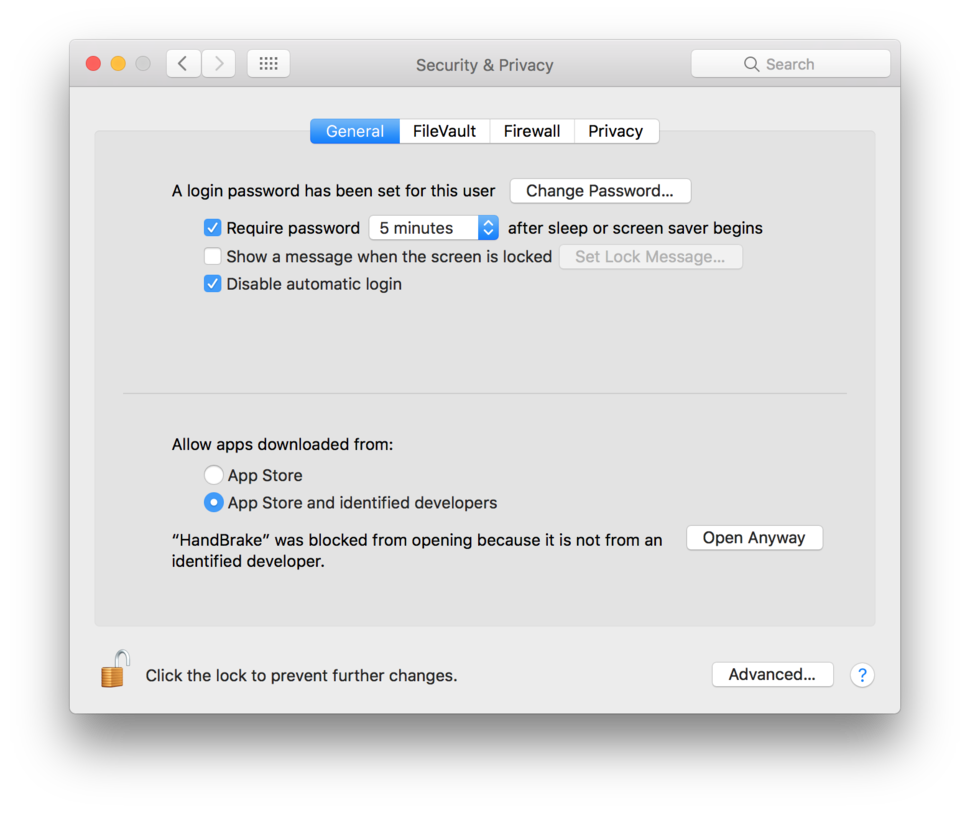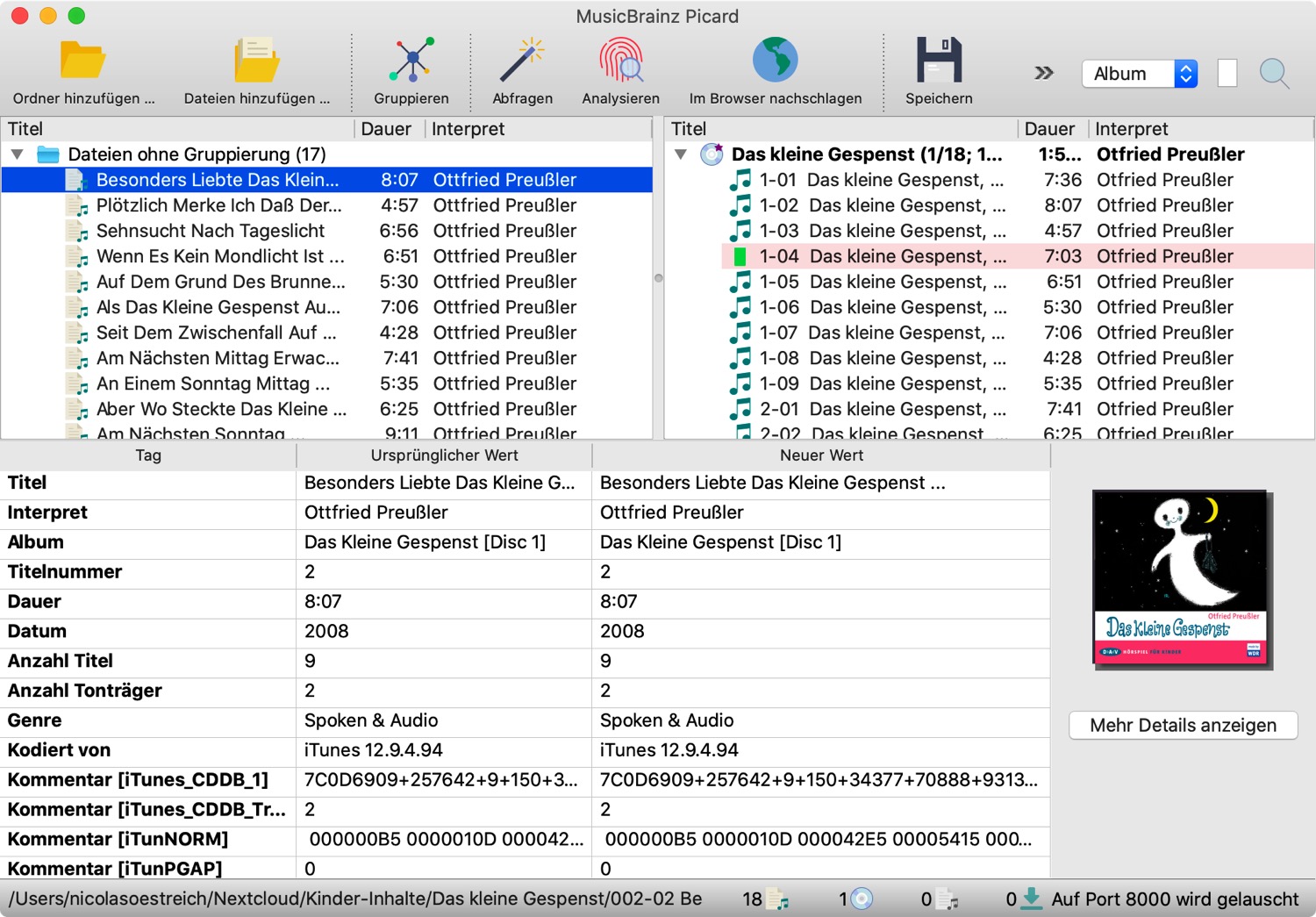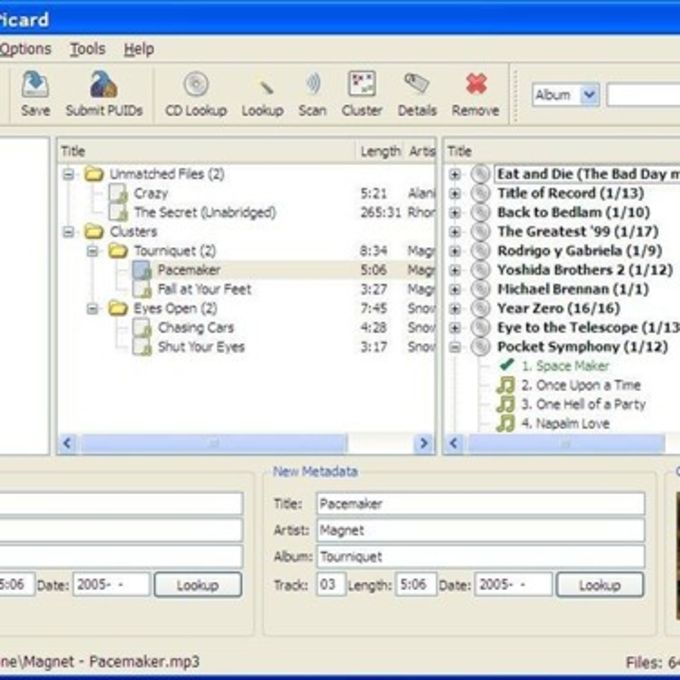I've just compiled PicardQt on the Mac. I will attempt to gather together information on (and record my own experience of) using PicardQt in conjunction with iTunes which I'm guessing is by far the most used Music playing app on Mac OS X.
This is a bit of a work in progress at the moment mostly for me to gather my own thoughts but feel free to add to this.
MusicBrainz has expanded its goals to reach beyond a CD metadata (this is information about. Download musicbrainz picard mac, musicbrainz picard mac, musicbrainz picard mac download fre Download MusicBrainz Picard for Mac. Picard is a cross-platform music tagger written in Python. Picard supports all popular music formats, including MP3, FLAC. The files should be in folders named Artist/Album Name, drag and drop them onto Picard. Since you have the CD in the machine anyway, lookup the CDID in Musicbrainz. This ensures that it exists and that it is pointing to the correct album.
Note: I've built Picard initially without audio fingerprinting. My collection mostly consists of CDs where every track has been ripped so I'm hoping that Picard can handle such cases without having to process the files beyond reading the tags.
- 5Suggested Workflows
Hints and Pointers
- iTunes doesn't seem to pick up the changes in its tags automatically. Playing or showing the info on a file will update that single file's info in iTunes. Selecting files in library and then dragging them onto sidebar to create a new playlist will cause iTunes to refresh files' info. You can also try Consolidating your Library, which updates all its files (and copies all files into its file hierarchy at the same time!). The best method (assuming you have iTunes organizing your files) seems to be dragging and dropping the folder of changed files onto the iTunes window.
- The 'magic wand' lookup button seems to do something different, and much more useful than the lookup button inside the new metadate section in the bottom right.
- You can use the 'magic wand' on multiple clusters at once by multi-selecting them (shift-click or command-click). The same is true of Save and probably several other things.
- iTunes has a special folder/artist called 'Compilations'. This is where it gathers what MusicBrainz would call 'Various Artist' releases. Clustering this seems to work well and it probably makes sense, if you're cleaning up your entire collection, to locate all your VA compilations, select all tracks and make sure the 'Compilation' flag is set on them in iTunes. You can then process the Compilations folder first, cleaning up the artist folders to only contain mostly whole albums.
- Multi disc releases that have been combined using iTunes disc x of y functionality confuse the clustering. They're treated as one big long disc. The way to work around this seems to be as follows: Cluster the files. Select the cluster and do a manual lookup. All the discs of the release should appear in the search results. Click on the tag next to all of them. Drop the cluster on one disc. Drag the unmatched files back over and drop them on the word 'clusters'. Drag the cluster over onto a different disc. Repeat as necessary. Beware of tracks ending up on the wrong disc.
- An alternative approach to the above, instead of doing a manual lookup you can use the wand on a single file from each disc of the release.
- Similarly it seems to match misplaced tracks you must drag them back over to the left-hand pane first, before dragging them back to their rightful place.
- Important Note: iTunes (while running) will be aware of any filename changes for songs in its library. This is great as you can drag your library into PicardQt to update filenames and tags and iTunes will not 'lose' the files. --AaronCooper
- You can drag files and folders in from the finder which is handy and lets you use the standard multiselect features (shift-click and command-click to choose multiple files/folders). This is handy for example, if you wanted to tag part of your library, say all artists from A-D, or only certain albums by an artist.
- I had some albums that were encoded weirdly and Picard didn't pick up the tags, instead just displaying the track name. These stand out as the cluster algorithm ignores them. However, the 'set tags from trackname' menu item worked perfectly because I had iTunes set to move and rename files based on tags so the info was all there in the file and folder names.
Bugs and Annoyances
- multiple disc releases aren't connected when looking up, meaning you could end up with some tracks on a disc from a completely different set.
- The shortcut to remove listings is 'delete'. This key does not exist on Mac portables, causing you to hold down fn-backspace.
- It can be annoying if you've got a few stray files by an artist, and the matched clusters are under a slightly different spelling. To keep them together it would be good to select them all, enter the new name and save, leaving the rest of the tags as is. Though this is quite simple to do via iTunes itself.
- Some functions may appear to stop responding at random intervals. This often seems associated with drag and drog mixups. A restart can fix this.
- Clustering can sometimes become 'stuck', clicking cluster again restarts the process, but beware of albums in the middle of clustering that will end up divided in two separate clusters. There appears to be no easy way to merge these clusters but dragging and dropping both onto the looked up album seems to work okay. (I should check whether you can drag and drop both at once). It's possible this happens because the list of files has not been fully processed by Picard (i.e. they are still greyed out and time shown as ????) by the time the clustering function gets to them.
- There seems to be no way to clear everything other than a restart.
- The genre of 'Club-House' appears to be being added to some of my files, for no obvious reason and without an obvious pattern as yet.
- Having a duplicate file in the folder seems to confuse it. For example, if you happened to have the last track duplicated, but with the wrong title. The incorrectly titled one could grabbed and then it appears impossible to swap them.
- Dragging incorrectly matched files seems to really confuse matters. Rather than grabbing the file to be matched, you seem to grab both the file and its (incorrect) target. You can even end up with extra sublists that shouldn't be there.
- Something appears to have duplicated one of my files. Possibly editing it in Picard while playing it in iTunes at the same time.
Open Questions
Things to investigate:
- does clearing existing tags deleting anything important (ratings, playcounts?)
- It hasn't for me but I'm on Mac OS-X which apparently updates iTunes when track names change -AaronCooper
- How does album art integrate with iTunes (embedded vs stored separately)
- Does clearing Genres make sense?
- Compilations with album artists, where do they get stored?
- It is up to your file naming scheme. I put mine always under the release artist, so VA albums go under 'Various Artists' or whomever the release is attributed to. -AaronCooper
- Does it work with Apple Lossless?
- Sure does! -AaronCooper
- Do video files confuse it?
- Nope, I have been able to tag my Metallica - S&M DVD rip (which was MPEG4). -AaronCooper

- Does the sorting info get stored in an iTunes compatible manner? (At first glance it appears so)
- I didn't think so, I thought that was iTunes that automatically calculates sort info. -AaronCooper
- Yes, it is stored properly, and it's not iTunes calculating it (at least for the Japanese artists I've tested it with). -DarrenKulp
- A related problem, changing the artist sort order of any tracks not found in MB is tricky. You can't seem to change more than one file at a time.
- This is a problem with iTunes and doesn't really need to be here (rather, it should be on an iTunes forum) -AaronCooper
- What's the path to the CD/DVD drive on Mac OS X?
- This can change depending on which drives you have mounted. Open Terminal, type
/dev/rdiskand tab until it shows you the list of available sources. If you have music CD inserted, you should see one with several copies (one for each track). Put that into PicardQt (mine reads: /dev/rdisk5). -AaronCooper
- This can change depending on which drives you have mounted. Open Terminal, type
Benefits of using MusicBrainz with iTunes and iPods
- Cleans up and merges near duplicate artists e.g. : 'Booker T and the MG's', 'Booker T. & The Mgs', 'Booker T and the MGs', 'Booker T & The MGs'
- Adds Artist Sortnames, so all the Jacksons will be listed under 'J',
- Adds Album Artists so you can find songs by e.g. the DJ or Soundtrack composer who put them together but also the artist who actually performed them
- (composers? need to check if this works)
- Composer info is stored in the tags, yup! -AaronCooper
- Adds Album titles to all those tracks from 'Unknown Albums' you've collected, making it easier to get album artwork.
Suggested Workflows

These assume that you are allowing iTunes to manage the location of the files, updating the filename and location whenever it changes the metadata. If you change the info with Picard, iTunes will not instantly update the display. To do this drag and drop the folder(s) with changed info onto iTunes, or use the Advanced -> Consolidate Library option. Both these options may worryingly claim to be 'copying files' but if you let iTunes manage your filenames and locations it will simply be rearranging them within the folder it controls.
Cleaning Up a Whole Collection
Before you start it is worthwile making a couple of changes in iTunes:
- 'Compilations' & 'Various Artists': iTunes allows you to mark releases as being 'compilations'. This is the same concept as 'Various Artist' albums in MB, that is an album where not every song is by the same person. However this data is widely misused for Best Of and Anthology albums. It's a good idea to locate all your various artist albums and set the 'compilation' flag on each track, and locate albums that are only by one artis that have been mistakenly set as 'compilation'. This has the effect of placing all these tracks in the Compilations folder, which means you can drag and drop entire albums into Picard, rather than hunt through 20 or so folders to find all the tracks.
Musicbrainz Picard Hangs
Updating to the most recent MB data

Musicbrainz Picard Portable
Ripping a CD
Musicbrainz Picard Tutorial Mac
- First insert the CD into iTunes and see if it is recognised.
- Click on the CD in the source pane on the left.
- If it's not recognized then add the artist and album name. Don't worry about track names.
- If it is recognized, you can fix any terrible errors in artist or album name
- Make sure to mark it as 'compilation' only if it is a Various Artists release, and set or delete the Genre (the genre will not be replaced or deleted by Picard by default and the default will probably be next to useless)
- Rip the CD
- The files should be in folders named Artist/Album Name, drag and drop them onto Picard.
- Since you have the CD in the machine anyway, lookup the CDID in Musicbrainz. This ensures that it exists and that it is pointing to the correct album. Otherwise you might find the tracks being associated with very similar release, say from another country, or a re-issue with a different number of tracks.
- Adding release year barcodes, catalogue numbers and any other info you can read from the disc or packaging to existing entries would be appreciated.
- When you've got the album on screen, click the tagger icon to load it into Picard.
- Cluster, drag and save as usual.
- To update the file info in iTunes, drag and drop the folder containing the album onto the iTunes window.
